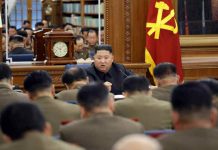[imText1]The spread of infectious diseases is on the rise in North Korea due to the flood disaster.
The flood which targeted Pyongyang, north of South Pyongan, north of South Hwanghae and the rivers around Kangwon province is rapidly spreading diseases throughout the waters, North Korean state-controlled media informed.
During the months of July and August, North Korea faces the annual rainy season. It is a time when infectious diseases such as typhoid, cholera and dysentery are rampant as people drink from the contaminated rivers and wells.
As North Korea’s waterways and filtration systems are old and corroded, it is difficult to control water-purity and hence acquire clean water. Even within the cities, some households have the privilege of private water taps, while others still have to access communal water supplies.
There are no separate sewage disposal facilities in North Korea. Water is collected from the reservoirs and disinfected. In the cities, if electricity has been suspended, water supply is also suspended. Electricity operates only 1~2 hours per day and during this time water must be collected from the taps. If this opportunity is lost, people must obtain water from nearby rivers or streams.
Waiting for deposits in the water to settle at the bottom
Diseases spread after a flood because ▲ of contaminated rivers depreciating water quality ▲ poor control over water systems ▲ decline in people’s health due to chronic food shortage and ▲ a shortage of medical supplies and preventative treatment. There is a high chance of people becoming sick with contaminated water spreading diseases through malnourished bodies and weak immunity.
Following the mass flood last year and the recent flood in the South and North Hwanghae, South Pyongan and Kangwon province, the spread of diseases such as typhoid, cholera and dysentery is expected. It seems that North Korean authorities are already making efforts and taking action in preparation for this.
In a newsletter published by the Chongryon, the Chosun Shinbo, Cha Chul Woo the vice-director of the Center for Hygienic Prevention of Epidemics said on 21st, “Above all, we are placing great efforts in trying to implement measures that will exterminate the roots of infectious diseases.”
Similar to the mass flood in 1995, it is likely that the recent flood disaster will permeate infections. Even during the disaster of 1995, people drank contaminated waters for a long time after, though this may be difficult for South Koreans to perceive as they drink water from the water purifiers or purchase bottled water.
In North Korea, water of the water supply facilities is gathered from the overflowing floodwaters. In some cities, a reservoir is constructed at the peak of the tallest mountain as a catchment area where water is collected and purified.
Not even enough firewood to boil water
During the rainy season, people collect water in large basins and wait for the dirt to gather at the bottom. This water is then used for drinking and to cook rice. Hence, it is common that the cooked rice is yellow.
After the flood in the mid-90s, many people began to get diarrhea, dysentery and cholera having consumed contaminated water. One of the symptoms of dysentery is pains in the lower stomach and severe diarrhea mixed in blood.
Last year, on the seaside coast of Hwanghae, worms, insects and rusty water was found to have come from the taps. Contrastingly, elite officials and the rich enjoy tea having collected their water from the springs or basins that have been installed and connected to the mountains.
Medical examinations available but no prescriptions
One of the reasons that infectious diseases spread rampantly throughout North Korea is due to the fact there is insufficient medicine and preventative treatment. North Korea’s health systems allows for citizens to receive free medical treatment, however this policy lies in vain as there is not enough medicine to go around.
Doctors attend to patients in North Korean hospitals with great hospitality, but it is difficult to receive prescriptions, while a fee of 5,000~10,000won is charged for home visits. However, much more medicine can be purchased with this money and hence, people tend to prescribe medication for themselves.
Another reason is the overly priced medicines. Cheap medicine is on the whole fake medicine manufactured in China. Even up to early this year, a disposable needle cost 200won at the markets in Shinuiju, while 25mg of amplidyne containing 40% glucose costs 250won each and a packet of tablet used to treat diarrhea, 300won.
Tradesmen from the country have already made their way to the markets in Shinuiju to purchase antibiotics, medicine, glucose and needles. This is because infectious diseases are expected to spread following the flood disaster.
According to one inside source, “It costs around 3,000won per day for a patient to get an injection and medicine. On average, there is a one month waiting period to receive treatment which means a person needs to have 100,000won to be able to treat illnesses.”
On the other hand, as preventative measures to the diseases, North Korean authorities merely give the advice, “Drink boiled water. Get into the habit of sterilizing your bowls and cutlery.” Even if a person does get sick, measures end with “isolate the patient.” However, these measures are useless in North Korea as coal, fuel and firewood is more expensive than the cost of rice.
The source said, “Even if you are dying of hunger or sickness, authorities enforce education” and “Even as the people are dying from diseases, the government does not propose any alternative measures.”




















